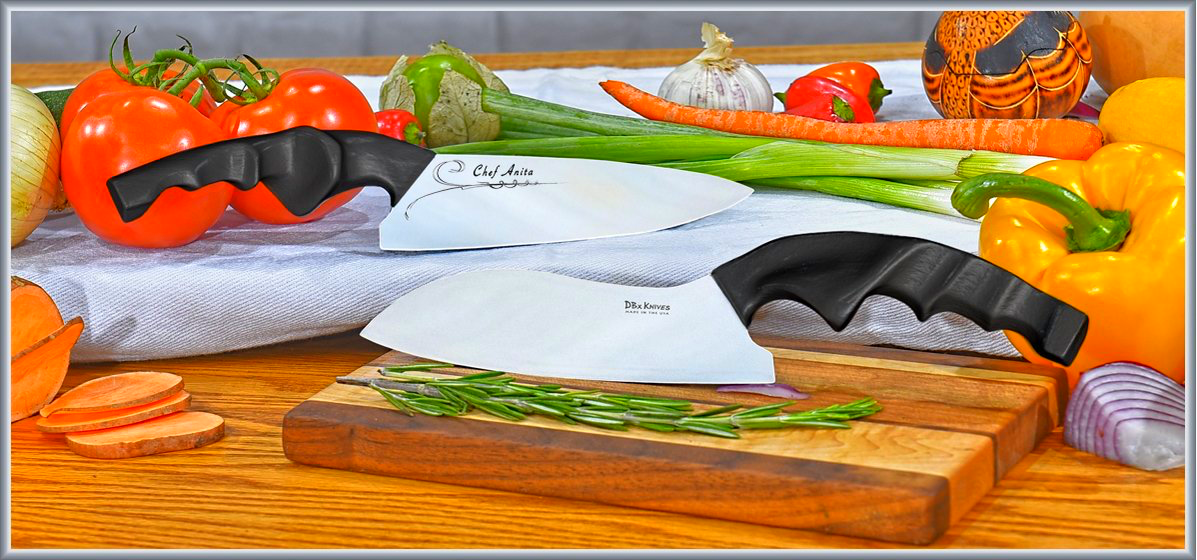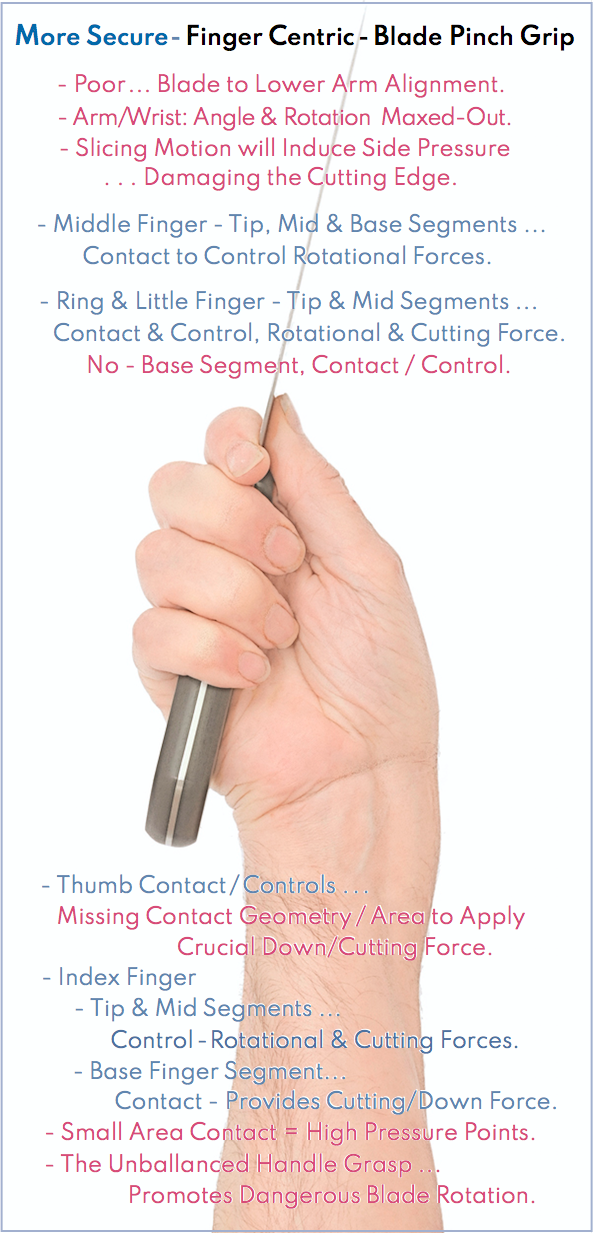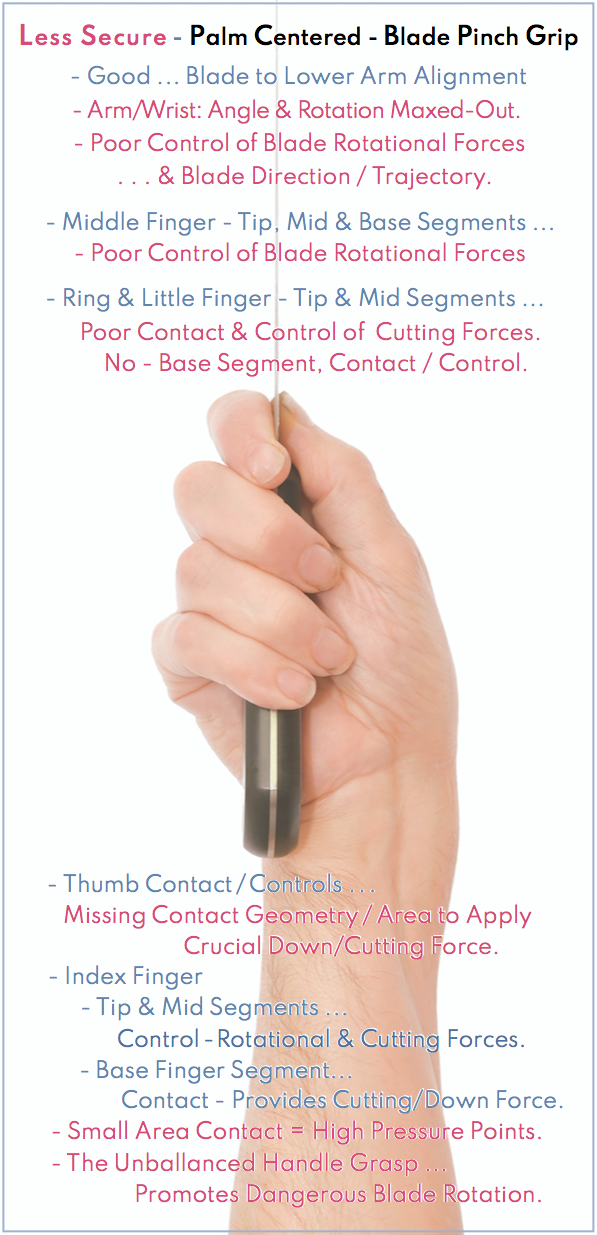Positive Indexing
- This adds comfort & safety to the knife use/design.
- A "positive indexed" knife is characterized by the relationship of:
- Neutral/natural wrist rotation,
- To natural knife handle grasp,
Creating a positive blade angle.
Positive knife blade angles imply a blade rotation slightly away from food control hand.
Traditional Knife Grip
Safety Concerns
- Utilizing a pinch grip to create more downforce... creates extremely high pressure points in the index finger which can be painful.
- The spine of the knife is a very small/uncomfortable area to apply downforce.
- The standard knife grip limits much of your ability to control knife roll-over.
Culinary - Handle Design
Selecting &
Using
Knives,
Tips &
Info.

" The Secret behind a Great set of Knives is in the Handle."
Gordon Ramsay
Basic - Ergonomics
Opposing
Grasp Forces =
Grip
Strength.
Human Grasp . . .
-The knife handle serves as the connection between you, the blade & the food you are preparing.
- Optimized culinary knife handle designs complement the natural capabilities & strengths of the human hand.
- We depend on our ability to create opposing forces within our grasp to maximize our effective grip strength.
- Contoured & faceted/flattened areas,
correlating with the bone structure of our hand,
further enhance effective grip strength.
- DBx-Knife Handles are individually sized & geometrically designed around these fundamental principles.
- The enhanced safety & ergonomics these handles provide is unparalleled in the world today.
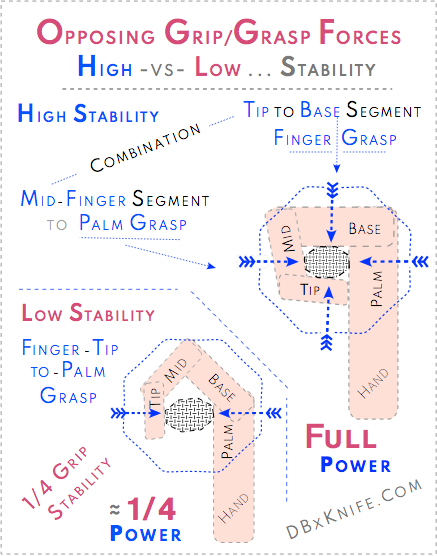
Hand to Handle ~ Our Grasp
Increase:
Grip Strength / Knife Control
Chefs/Cooks, Culinary Knives
- Traditional culinary knife handles lack the geometrical design elements to optimize our grip strength.
- Enhanced safety & knife control are achieved through: handles designed to engage the palm, each finger segment, joint & the thumb.
- Ideally, our index finger wraps around the handle to provide balanced opposing forces to our thumb.
- The middle, ring & little fingers wrap around the handle to meet the palm ... creating horizontal & vertical opposing forces.
- The knife handle should engage: the palm, thumb tip & each finger segment, for a safer & more secure grasp.
- Select your culinary knives with these basic concepts in mind.
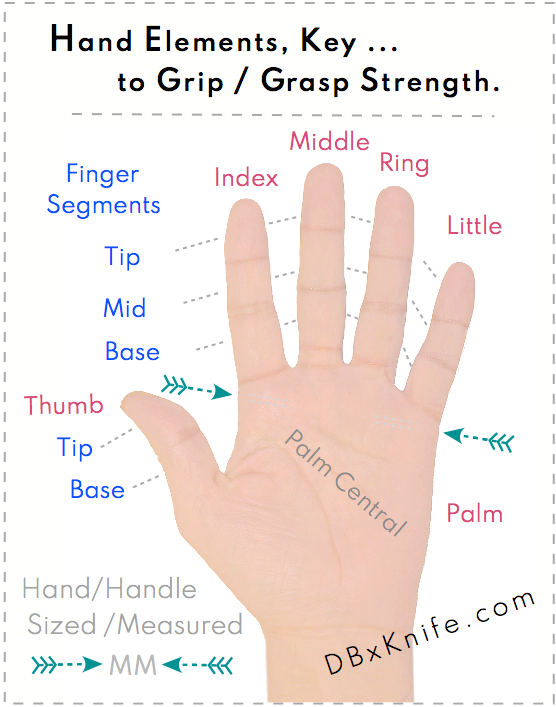
DBx Handle Ergonomics
Handle Centric -Pinch Grip Logic
DBx-Handle Grasp . . .
- Asymmetrical handle geometry, correlating with your natural grasp, alleviates many issues.
- These handles minimize stress & peak pressure in the musculoskeletal structures, of the hand & wrist.
- DBx-Handles provide geometrical facets (grip areas) for individual finger segments, joints & the thumb.
- DBx-Handle geometry is optimized to leverage the stronger base & mid-finger segments for power transfer.
- Ideally, we engage a knife handle at the intersection of our palm & base of our fingers, enhancing our grip strength.
- Wrist angles are significantly reduced for more cutting power with less stress.
Optimized Ergonomics . . .
- Precisely . . . sized & placed handle facets, mitigate the dangers of a knife slipping/rotating in our grasp.
- Contours in DBx-Handles prevent . . . our hand from sliding forward into the blade & the knife from slipping out of our hand.
- DBx-Handles are geometrically contoured & sized, to provide control unmatched in culinary knives.
- Individuals with: hand injuries, joint pain, or arthritis may benefit the most from custom DBx-Handles.
- Safety,
comfort & control are prioritized
in our data driven kitchen knife.
blade & handle designs.
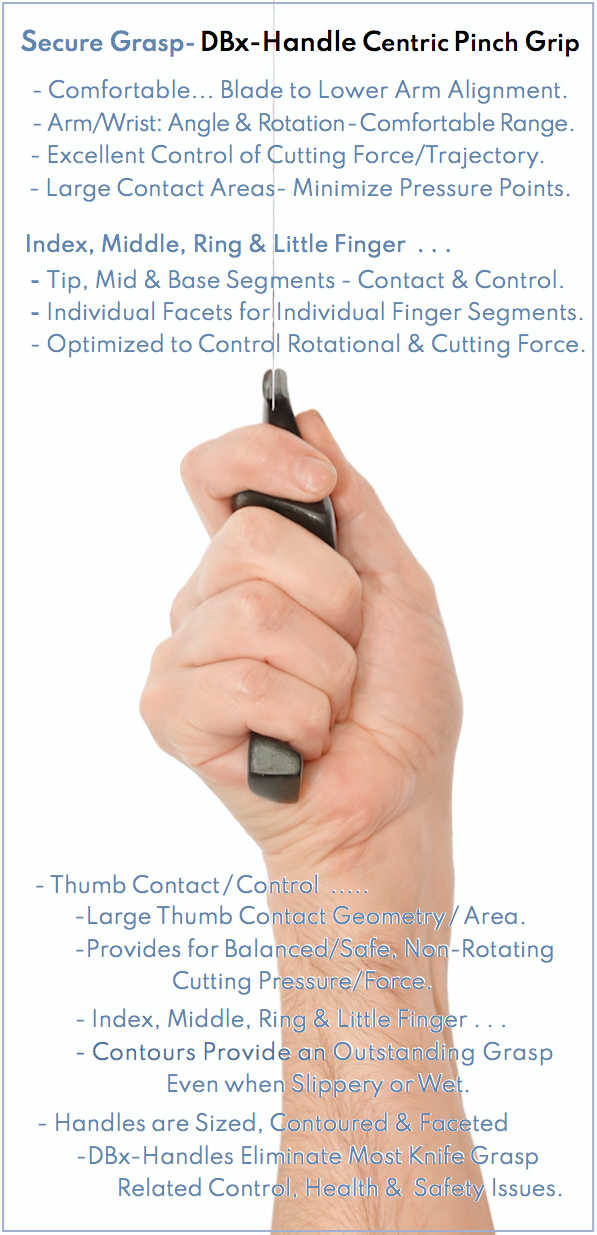
Handle to Blade Alignment
Dulling/Rolling... Cutting Edges
- Culinary knives are often dulled from non-linear input forces, rolling the cutting edge.
- Asymmetrical DBx-Handles are designed to reduce non-linear input forces (side pressure), which often rolls the apex.
- Blade to lower arm alignment is key to reducing side pressure on the cutting edge.
- Side pressures applied to a knife, in contact with a cutting surface, rolls the cutting edge.
- Note: Thinner knife blades are more forgiving, often flexing enough to avoid rolling the cutting edge.
- We often sense the blade flexing & improve our technique,
preserving the cutting edge.
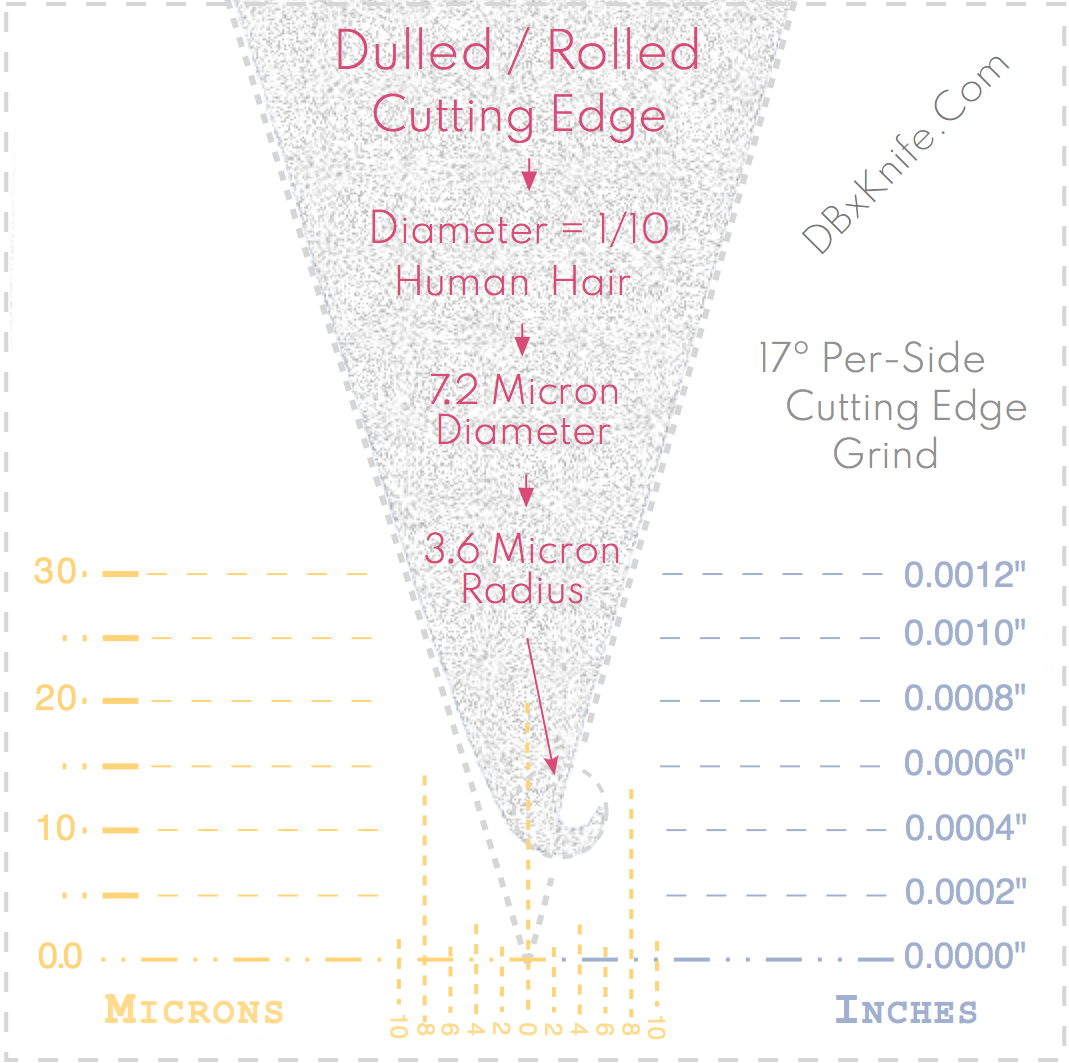
Trading Safety for Comfort
Current Realities . . .
- Traditional knife handle designs motivate us to trade safety for comfort.
- We resort to a knife handle grasp where cutting power is transferred through . . .
-The weakest segments/tips
of our smallest fingers.
-Extremely small areas of our
forehand & index finger.
- Unreasonable expectations delegated to tips of our smallest fingers include. . .
-Countering downforce created in
the palm & forward portion
of our hand, along with...
-Rotational & directional control of
the knife blade/cutting edge.
- The forehand & index finger apply forces into the same side of the blade spine & handle . . .
-These forces rotate the knife blade's
cutting edge toward our hand
controlling the foods we are
preparing.
Compromised Safety . . .
- There are several logical reasons we compromise our grasp & safety when handling a kitchen knife.
- Home & professional cooks/chefs frequently alter their grasp to avoid: tissue damage & increase cutting forces.
- This practice limits our ability to establish an intuitive understanding of: blade trajectory & cutting-edge position.
- Rotational & directional control of the knife blade is compromised by a hand . . .
- Too large/small to engage the base
& mid-sections of our fingers.
- Missing and/or incorrectly sized &
placed thumb control surface.
- Ideally, handle geometry is optimized to engage the stronger base & mid-finger segments to improve control & power transfer.
- Custom DBx-Handles are designed to overcome these safety
issues
& more.
Traditional Pinch-Grip Styles
Pros & Cons
Handle/Grasp Issues
Oval/Round vs. Rectangle
- Traditional Oval/Round handle designs often provide a more comfortable grasp than flat-sided handles.
- Flat-sided handles provide a better reference to understand blade angle/indexing than round or oval handles.
- These handles yield an inconsistent
grasp, compromising our intuitive understanding of blade angle & position.
- “D” shaped handles are an intelligent mix of the two, while maintaining traditional inappropriate linear alignment with the knife blade.
- Classic culinary handle designs fail to provide adequate thumb control surfaces to offset unsafe rotational input forces.
- Traditionally, handles seem to reflect knife crafters' desire to produce a simple & economical product.
- A questionable compromise,
especially if you use a knife daily and/or have physical limitations.
Design Concerns ...
- Any uncomfortable or inadequate handle grasp will be changed often, limiting our intuitive understanding of knife blade: position, rotation & trajectory.
- Symmetrical culinary knife handles, aligned with knife blades, limit our ability to control blade angle & transfer power.
- Knife handles, too large to wrap our middle, index & small finger around, limit our effective grip strength / blade control.
- Handles missing thumb control surfaces diminish our ability to safely control down-forces applied by the fingers.
- Knife handles, which reduce our ability to engage the base of fingers, limit our ability to safely control cutting forces.
- Grasp to handle mismatch yields: small grip contact areas & painful high-pressure points in our hand.
- We address these issues with ergonomic,
geometrically corrected & precisely sized,
culinary knife handle
designs.
Power/Pinch Grip
Power/Handle Grip . . .
- Power Grip... Fingers wrapped around the handle with the thumb placed on top.
- Handle Grip... Place the palm on top of the handle with fingers & thumb to either side.
- These grip styles yield a comfortable wrist angle & a larger area to apply cutting force.
- Unfortunately,
biased
rotationally
down
forces applied
biased,
rotating the knife blade toward the user's hand,
increasing risk of injury.
Pinch Grip . . .
- A traditional blade-centric pinch grip is the preferred option for cooks & chefs, but not ideal for many reasons.
- To overcome these issues, data driven asymmetrical geometrically corrected handle centric-pinch-grip handles were created.
- DBx-Pinch Grip Handles are sized & contoured for a comfortable, high-strength grip, which leads to a consistent grasp.
- A consistent grasp,
over time,
provides the user with an intuitive understanding of blade position & direction/trajectory.
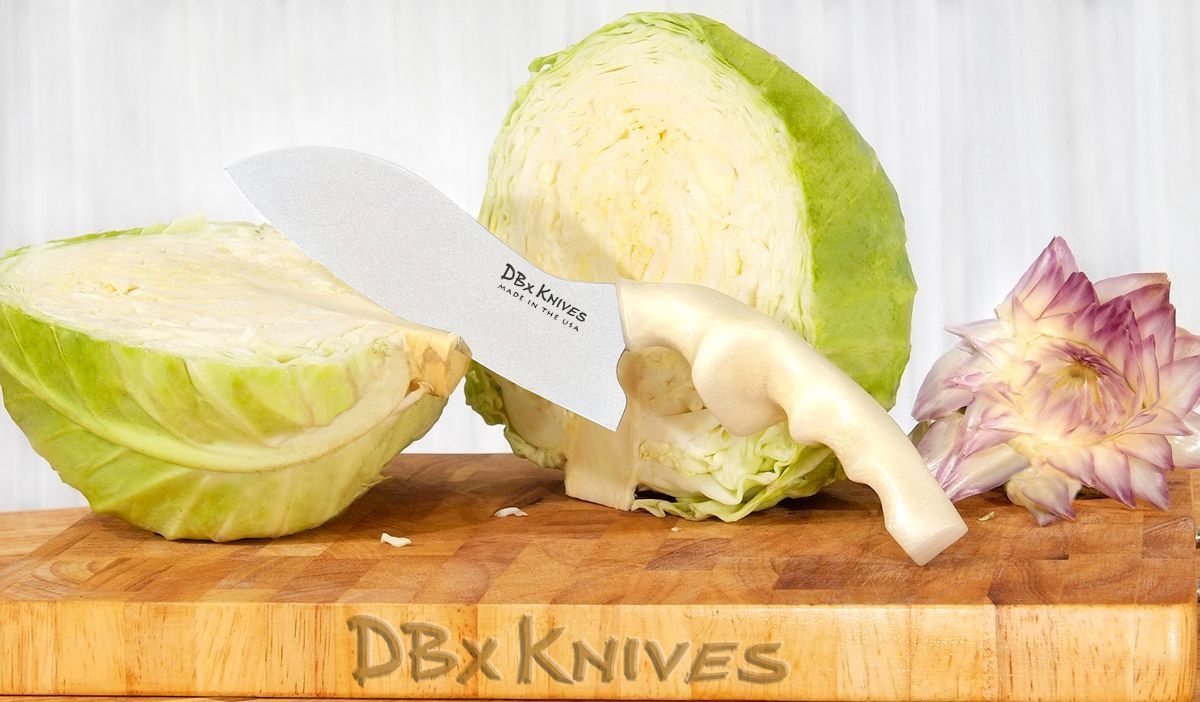
Traditional - Knives/Handles
Our Interaction w/Traditional Chef's Knives
Our First Grasp ...
- Picking up a knife, we seek a comfortable grasp, or at least one, which results in the least amount of pain.
-The difference between one’s natural grasp & handle geometry,
creates unnecessary stress levels in wrist/hand.
- Soft tissue & muscle surrounding the bone structure in the hand, absorb some of the difference to enhance our grasp.
Preparation to Cut ...
- We compromise our grasp to align the knife with our lower arm & the foods we intend to cut.
- This often includes . . . extreme wrist angles, using the weakest portion of our hands (our fingertips), to power & guide the knife.
- Now,
we have an uncomfortable and less secure grasp,
limiting our ability to power & guide the knife
through our foods
safely.
Making the Cut or Not !
Our First Cut ...
High-Density Foods
- While attempting the first cut, we realize our compromised grasp still needs to be improved.
- Frequently, with this grasp, we cannot transfer the force needed to cut our food.
- But we are still hungry, so we are willing to accept additional risk & pain.
- We adapt, resorting to an even more uncomfortable handle grasp, necessary to make the cut.
- Unfortunately,
at this point,
we have traded our personal safety for the power to cut our food.
"Can't Cut That" . . .
- There is a point at which we all give up & declare we cannot cut our food.
- It’s frequently not that we lack the strength to generate the blade force required to cut our food . . .
- More often, it's the pain we experience and/or the perception that we may lose control of the knife.
- Unfortunately, we have all been cut & possess an appropriate fear of cutting ourself again.
- It's time to update 3,500-year-old culinary knife handle designs creating safer & less painful knives.

